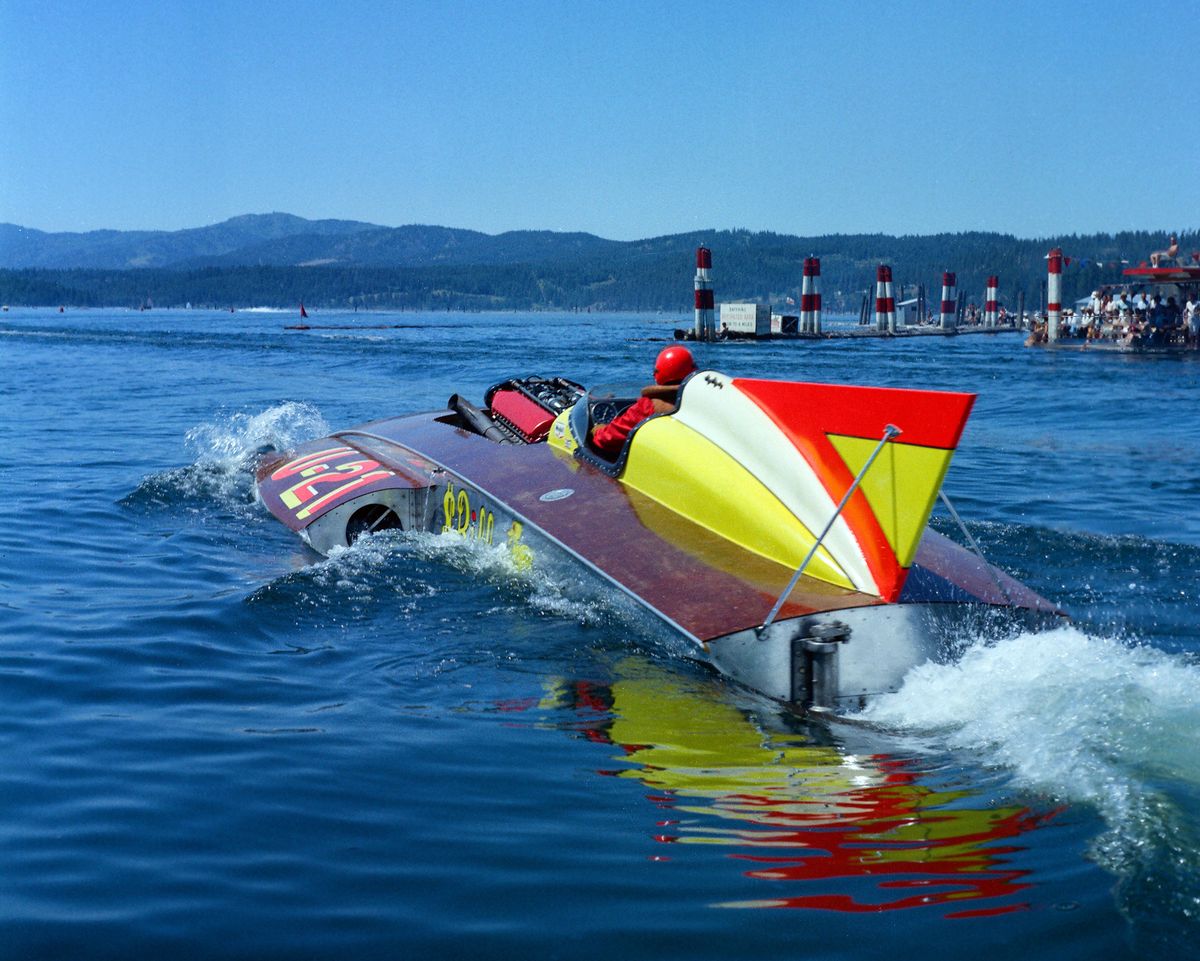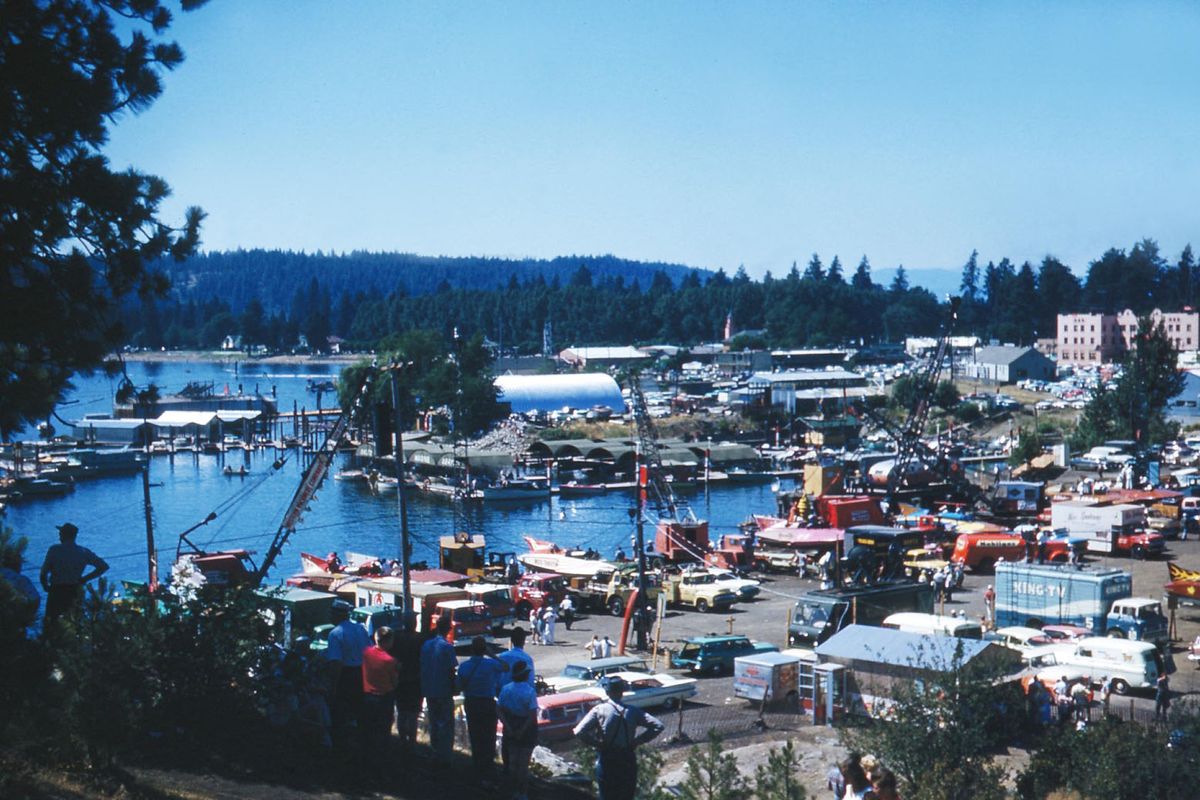Hydroplanes return to Lake CdA for weekend museum fundraiser
The U-21 cruises Lake Coeur d’Alene on July 20, 1962. Hydroplane races were held on the lake from 1958 to 1968.
For the first time in more than 40 years, hydroplanes capable of speeds up to 175 miles per hour will zoom around Lake Coeur d’Alene this weekend.
But they will not race, as they did in the 1950s and 1960s, drawing some of the biggest crowds ever seen at an Idaho sporting event, but also generating controversy due to unruly spectators.
The vintage boats are coming to Coeur d’Alene, complete with drivers and pit crews, from the Hydroplane and Raceboat Museum in Kent. They’ll be here for the Diamond Cup Regatta, a fundraiser for the Museum of North Idaho. The weekend of events will include a display of the boats outside The Coeur d’Alene Resort on Friday afternoon, a Saturday night banquet and rides on Sunday for 12 lucky people.
A dozen rides in the historic boats will be auctioned and raffled off at Saturday night’s banquet and delivered on Sunday afternoon in the middle of the lake, just off the North Idaho College beach. Raffle tickets are being sold for $10 each at several North Idaho businesses.
Event organizer Doug Miller said the speeds the boats reach will depend on water conditions and the passengers’ nerves. The boats’ cockpits will be modified to fit two people, with the passenger sitting beside the driver, three feet behind the roaring V-12 engine. The boats that will be in Coeur d’Alene this weekend are the 1968 Miss Budweiser, 1960 Miss Thriftway, 1962 Miss Bardahl and the 1957 Miss Wahoo.
In addition, Mira “The Flying Czech” Slovak, of San Diego, will deliver a keynote address at Saturday’s banquet. Slovak was driving the Miss Exide during the 1963 Diamond Cup when it crashed. Now 80, Slovak also won the Diamond Cup in 1966 in Harrah’s Tahoe Miss.
This will be the first fundraiser for the museum, which is launching an effort to raise $8 million for a new building, said Director Dorothy Dahlgren. An agreement with the city calls for a new museum to be built one day at the corner of Northwest Boulevard and Government Way, next to Memorial Field, she said.
Miller approached the museum about a year ago with the idea of a fundraiser related to hydroplane history, Dahlgren said. “We thought it was great that somebody in the community wanted to help the museum out and help promote history in the region,” she said. “There’s a lot of people still living who were involved in the races and have very fond memories of them.”
The races also drew controversy. They were held on Lake Coeur d’Alene from 1958 to 1968, attracting thousands of people and delivering the city’s first national television exposure, according to an exhibit at the museum. The late Roger Hudson, whose family has owned Hudson’s Hamburgers in downtown Coeur d’Alene for more than 100 years, is quoted in the exhibit remembering the noise the boats made when six of them pulled up to the starting line together.
“The reverberation of noise off Tubbs Hill was unforgettable,” Hudson said.
The boats and their pit crews were staged where the Third Street boat launch is today and spectators perched atop Tubbs Hill to watch. The racing ended after Saturday night crowds became unruly and citizens complained about the police and fire protection needed, along with the noise and litter, the exhibit says.
An effort to bring the hydroplane races back in 1985 resulted in an advisory vote to the City Council in which the idea was shot down by a 3-to-1 margin. The idea resurfaced in 1995-’96 and resulted in a ballot initiative banning unlimited hydroplane racing on the lake.
Dahlgren said, however, that the races also represent a part of the city’s history that many people remember fondly. “We felt the community would support hydroplanes in this venue as a historic part of Coeur d’Alene,” Dahlgren said. “We’re not proposing races.”
Miller agreed, saying he was part of the group in the mid-’90s that rejuvenated the idea of having races on the lake. “Lesson learned,” he said. “That’s not in the offerings or in the cards at all.”
Still, he’d like the boat display to become an annual event.
“It is an opportunity to see something that at one time was extremely popular,” said Miller, whose father worked on pit crews during the races in the ’50s and ’60s, when Miller was a boy. “The boats were one of the main sporting events for the country.”

